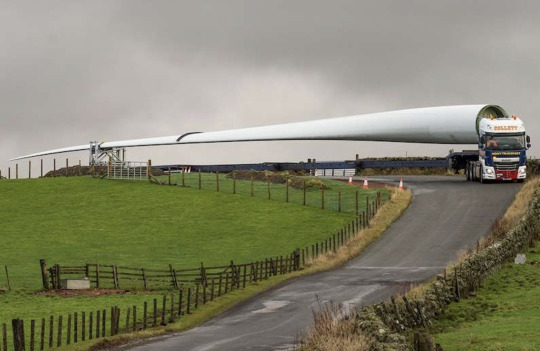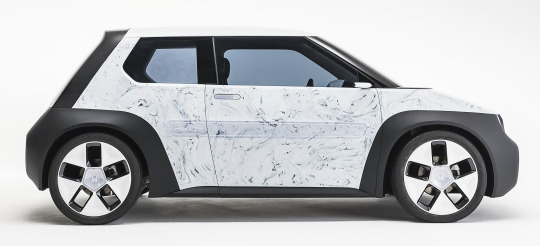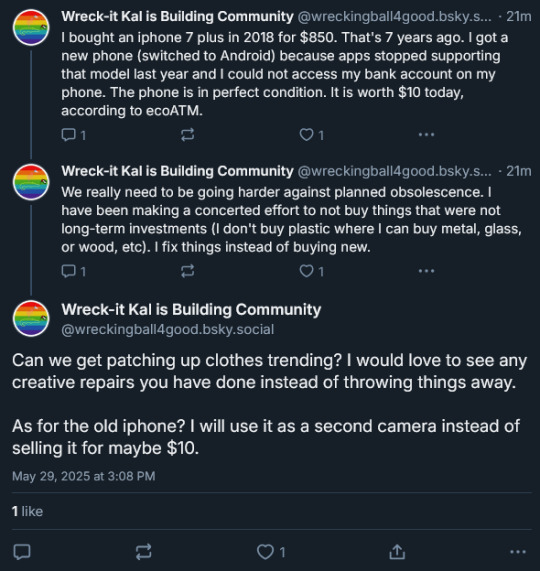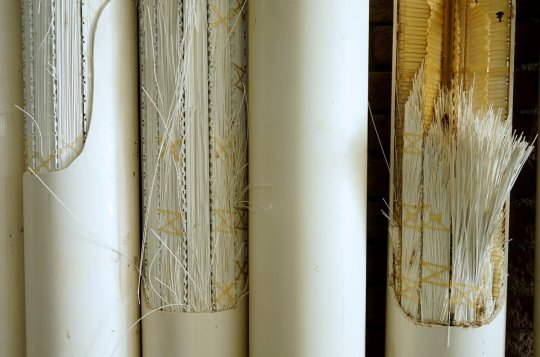#Technology Recycling
Explore tagged Tumblr posts
Text

123 Repairshop is dedicated to data destruction as part of our commitment to data protection and privacy. We understand the importance of securely disposing of sensitive information to prevent any unauthorized access or data breaches. Our comprehensive approach ensures that your data is protected throughout the entire repair and recycling process.
When it comes to data destruction, our technicians follow strict protocols to ensure the complete and irreversible erasure of data from devices. We utilize industry-leading software and techniques to securely wipe all data, leaving no traces behind. This process applies to both personal devices and business equipment, guaranteeing the highest level of data security.
In addition to data destruction, 123 Repairshop emphasizes environmental sustainability and responsible e-waste management. We offer electronic recycling options for old, damaged, or obsolete devices. Our technicians meticulously disassemble each item, separating recyclable components such as metals, plastics, circuit boards, and batteries. Through our partnerships with certified recycling facilities, we ensure that these materials are appropriately treated and processed, minimizing the environmental impact of electronic waste.
By choosing 123 Repairshop, you not only receive top-quality repairs and data protection, but you also contribute to a healthier planet. Our commitment to environmental sustainability, social responsibility, and data protection aligns with our belief in making a positive impact. We strive to support educational institutions, promote eco-friendly practices, and safeguard your valuable data.
Whether you need repairs, data destruction, or electronic recycling, we are your trusted partner in achieving your needs while making a positive impact on the world around us. At 123 Repairshop, we combine exceptional service with environmentally friendly practices, social responsibility, and data protection. Join us in our mission to create a healthier and more sustainable future by choosing our services.
#Vendor Certification#Technology Recycling#Sustainable Technology Solutions#Sustainable Practices#sustainable education#Student Internship Program#School Partnerships#Responsible Procurement Community Engagement#Recycling Partnership#Minority and Women-Owned Business#Hands-on Experience Training#Environmental Sustainability#Electronic Waste Management#Data Security Technology#Cost Savings Corporate Social Responsibility
0 notes
Text
Good News - July 22-28
Like these weekly compilations? Tip me at $kaybarr1735 or check out my new(ly repurposed) Patreon!
1. Four new cheetah cubs born in Saudi Arabia after 40 years of extinction

“[T]he discovery of mummified cheetahs in caves […] which ranged in age from 4,000 to as recent as 120 years, proved that the animals […] once called [Saudi Arabia] home. The realisation kick-started the country’s Cheetah Conservation Program to bring back the cats to their historic Arabian range. […] Dr Mohammed Qurban, CEO of the NCW, said: […] “This motivates us to continue our efforts to restore and reintroduce cheetahs, guided by an integrated strategy designed in accordance with best international practices.””
2. In sub-Saharan Africa, ‘forgotten’ foods could boost climate resilience, nutrition

“[A study published in PNAS] examined “forgotten” crops that may help make sub-Saharan food systems more resilient, and more nutritious, as climate change makes it harder to grow [current staple crops.] [… The study identified 138 indigenous] food crops that were “relatively underresearched, underutilized, or underpromoted in an African context,” but which have the nutrient content and growing stability to support healthy diets and local economies in the region. […] In Eswatini, van Zonneveld and the World Vegetable Center are working with schools to introduce hardy, underutilized vegetables to their gardens, which have typically only grown beans and maize.”
3. Here's how $4 billion in government money is being spent to reduce climate pollution

“[New Orleans was awarded] nearly $50 million to help pay for installing solar on low to middle income homes [… and] plans to green up underserved areas with trees and build out its lackluster bike lane system to provide an alternative to cars. […] In Utah, $75 million will fund several measures from expanding electric vehicles to reducing methane emissions from oil and gas production. [… A] coalition of states led by North Carolina will look to store carbon in lands used for agriculture as well as natural places like wetlands, with more than $400 million. [… This funding is] “providing investments in communities, new jobs, cost savings for everyday Americans, improved air quality, … better health outcomes.””
4. From doom scrolling to hope scrolling: this week’s big Democratic vibe shift

“[Democrats] have been on an emotional rollercoaster for the past few weeks: from grim determination as Biden fought to hang on to his push for a second term, to outright exuberance after he stepped aside and Harris launched her campaign. […] In less than a week, the Harris campaign raised record-breaking sums and signed up more than 100,000 new volunteers[….] This honeymoon phase will end, said Democratic strategist Guy Cecil, warning the election will be a close race, despite this newfound exuberance in his party. [… But v]oters are saying they are excited to vote for Harris and not just against Trump. That’s new.”
5. Biodegradable luminescent polymers show promise for reducing electronic waste

“[A team of scientists discovered that a certain] chemical enables the recycling of [luminescent polymers] while maintaining high light-emitting functions. […] At the end of life, this new polymer can be degraded under either mild acidic conditions (near the pH of stomach acid) or relatively low heat treatment (> 410 F). The resulting materials can be isolated and remade into new materials for future applications. […] The researchers predict this new polymer can be applied to existing technologies, such as displays and medical imaging, and enable new applications […] such as cell phones and computer screens with continued testing.”
6. World’s Biggest Dam Removal Project to Open 420 Miles of Salmon Habitat this Fall

“Reconnecting the river will help salmon and steelhead populations survive a warming climate and [natural disasters….] In the long term, dam removal will significantly improve water quality in the Klamath. “Algae problems in the reservoirs behind the dams were so bad that the water was dangerous for contact […] and not drinkable,” says Fluvial Geomorphologist Brian Cluer. [… The project] will begin to reverse decades of habitat degradation, allow threatened salmon species to be resilient in the face of climate change, and restore tribal connections to their traditional food source.”
7. Biden-Harris Administration Awards $45.1 Million to Expand Mental Health and Substance Use Services Across the Lifespan
““Be it fostering wellness in young people, caring for the unhoused, facilitating treatment and more, this funding directly supports the needs of our neighbors,” said HHS Secretary Xavier Becerra. [The funding also supports] recovery and reentry services to adults in the criminal justice system who have a substance use disorder[… and clinics which] serve anyone who asks for help for mental health or substance use, regardless of their ability to pay.”
8. The World’s Rarest Crow Will Soon Fly Free on Maui

“[… In] the latest attempt to establish a wild crow population, biologists will investigate if this species can thrive on Maui, an island where it may have never lived before. Translocations outside of a species’ known historical range are rare in conservation work, but for a bird on the brink of extinction, it’s a necessary experiment: Scientists believe the crows will be safer from predators in a new locale—a main reason that past reintroduction attempts failed. […] As the release date approaches, the crows have already undergone extensive preparation for life in the wild. […] “We try to give them the respect that you would give if you were caring for someone’s elder.””
9. An optimist’s guide to the EV battery mining challenge
““Battery minerals have a tremendous benefit over oil, and that’s that you can reuse them.” [… T]he report’s authors found there’s evidence to suggest that [improvements in technology] and recycling have already helped limit demand for battery minerals in spite of this rapid growth — and that further improvements can reduce it even more. [… They] envision a scenario in which new mining for battery materials can basically stop by 2050, as battery recycling meets demand. In this fully realized circular battery economy, the world must extract a total of 125 million tons of battery minerals — a sum that, while hefty, is actually 17 times smaller than the oil currently harvested every year to fuel road transport.”
10. Peekaboo! A baby tree kangaroo debuts at the Bronx Zoo

“The tiny Matschie’s tree kangaroo […] was the third of its kind born at the Bronx Zoo since 2008. [… A] Bronx Zoo spokesperson said that the kangaroo's birth was significant for the network of zoos that aims to preserve genetic diversity among endangered animals. "It's a small population and because of that births are not very common," said Jessica Moody, curator of primates and small mammals at the Bronx Zoo[, …] adding that baby tree kangaroos are “possibly one of the cutest animals to have ever lived. They look like stuffed animals, it's amazing.””
July 15-21 news here | (all credit for images and written material can be found at the source linked; I don’t claim credit for anything but curating.)
#hopepunk#good news#cheetah#extinct species#africa#nutrition#food#farming#gardening#pollution#climate#climate change#climate crisis#democrats#us politics#us elections#kamala harris#voting#recycling#biodegradable#technology#salmon#habitat#fish#mental illness#mental health#substance abuse#hawaii#electric vehicles#zoo
872 notes
·
View notes
Text
A New Resin is Able to Recycle Wind Turbine Blades Into Products Like Countertops and Diapers

From this article in Anthropocene Magazine:
Some companies are finding ways to recycle blades by shredding them and reusing the fiberglass and plastic resin to make cement and plastics. But the world will produce over 40 million metric tons of turbine blade waste by 2050, according to one study. That scale highlights an urgent need to make recycling blades easier. To address the issue, chemical engineering and materials science professor John Dorgan and colleagues developed a new resin made of a synthetic polymer and the plant-based polymer polylactide, or PLA, which is used to make biodegradable packaging. Fiberglass panels that the team made with the new resin were strong and durable enough for wind turbines and boat hulls. To recycle the panels, the researchers dissolved them in a solution and removed the glass fibers. The resin could then be used to make new panels or mixed with different minerals to make cultured stone for kitchen countertops. What’s more, the researchers could also treat the recovered resin in an alkaline solution to make an acrylic material for car lights or the absorbent material used in diapers. With some more chemical processing, they made a food preservative called potassium lactate, with which Dorgan’s team made gummy bears.
#wind power#wind energy#wind farm#wind turbine#recycling#clean energy#renewable energy#technology#adaptation#good news#hope#hopepunk#solarpunk#climate change#global warming
229 notes
·
View notes
Text
"As the world grows “smarter” through the adoption of smartphones, smart fridges, and entire smart houses, the carbon cost of that technology grows, too.
In the last decade, electronic waste has become one of the fastest-growing waste streams in the world.
According to The World Counts, the globe generates about 50 million tons of e-waste every year. That’s the equivalent of 1,000 laptops being trashed every second.
After they’re shipped off to landfills and incinerated, the trash releases toxic chemicals including lead, cadmium, arsenic, mercury, and so much more, which can cause disastrous health effects on the populations that live near those trash sites.
Fortunately, Franziska Kerber — a university student at FH Joanneum in Graz, Austria — has dreamed up a solution that helps carve away at that behemoth problem: electronics made out of recyclable, dissolvable paper.
On September 11, Kerber’s invention “Pape” — or Paper Electronics — earned global recognition when it was named a national winner of the 2024 James Dyson Awards.

When she entered the scientific competition, Kerber demonstrated her invention with the creation of several small electronics made out of paper materials, including a fully-functional WiFi router and smoke detector.
“Small electronic devices are especially prone to ending up in household waste due to unclear disposal systems and their small size, so there is significant potential to develop a more user-friendly end-of-life system,” Kerber wrote on the James Dyson Award website.
“With this in mind, I aimed to move beyond a simple recycling solution to a circular one, ensuring long-term sustainability.”
Kerber’s invention hinges on crafting a dissolvable and recyclable PCB board out of compressed “paper pulp.”
A printed circuit board (PCB) is a board that can be found in nearly all modern electronic devices, like phones, tablets, and smartwatches.
But even companies that have started incorporating a “dissolution” step into the end life of their products require deconstruction to break down and recover the PCB board before it can be recycled.
With Kerber’s PAPE products, users don’t need to take the device apart to recycle it.
“By implementing a user-friendly return option, manufacturers can efficiently dissolve all returned items, potentially reusing electronic components,” Kerber explained.
“Rapidly advancing technology, which forms the core of many devices, becomes obsolete much faster than the structural elements, which are often made from plastics that can last thousands of years,” Kerber poses.
PAPE, Kerber says, has a “designed end-of-life system” which anticipates obsolescence.
“Does anyone want to use a thousand-year-old computer?” Kerber asks. “Of course not. … This ensures a sustainable and reliable system without hindering technological advancement.”"
-via GoodGoodGood, September 13, 2024
#ewaste#e waste#e waste recycling#e waste management#e waste solutions#paper#sustainability#green tech#tech news#sustainable technology#recycling#good news#hope
586 notes
·
View notes
Text

Don't let Microsoft force you to buy a new computer and turn millions of devices into ewaste. Check out End of 10 for more info on how to keep your device going.
88 notes
·
View notes
Text




Honda Sustaina-C & Pocket Concept, 2024. Originally shown at last year's Japan Mobility Show, a new version of Honda's energy-efficient, low-carbon concept has been revealed. This time the bodywork is fabricated from recycled acrylic resin sourced from used taillights to create exterior panels that do not require painting. This material approach could reduce emissions during production by as much as 45%. The panels are crack resistant and able to return to their original shape following light collisions. It comes paired with the Pocket Concept, a compact electric motorcycle that can be stored in the luggage compartment and provide last mile mobility.
#Honda#Honda Sustaina-C#Honda Pocket#concept#prototype#experimental car#test vehicle#recycled#low energy#2024#design study#material technology
195 notes
·
View notes
Text
They r using machines to put snow that drifted down back into the top of the slope. They have automatic snow making machines that know the weather snd only make fake snow when the conditions are good. They pack the snow. The cold snow. From the slopes, Into these things where it just Exists during summer without melting much and they use thst snow again next winter. They have a machine to measure the depth of snow so they knoe how much they need to add. They recycle snow like crazy they're obsessed with it, they're freaks about it
Who's they?. Finnish skiing centres
#i'm doing a long ass environmental evaluation thing on them#the recycling of snow is genuinely cool NO PUN INTENDED but its also so funny to me for some reason#heres this fucking massive bag full of snow that isn't melting during summer because technology#to be clear ALL skiing centers dont have all these but they kinda gotta do environmental stuff to keep their business#afloat in the future too#and it tends to be pretty good for their business to do environmental stuff anyway. its good for almost any business#yeah okay#i dont know what this post is. someone needs to know i guess
45 notes
·
View notes
Text

Mura has declared the technology to be “revolutionary” because it “has the potential to help eliminate plastic waste, recycling all types of plastic to create a true circular economy”. Mura says that its process has lower carbon dioxide emissions and a higher tolerance for contaminated waste than does pyrolysis. It also emits roughly 80% less CO2 than burning the plastic in an incinerator to generate energy — a common way of dealing with waste. If that makes it sound like a panacea for plastics recycling, think again. In practice, as Mura explains, the plant is currently picky about its diet of plastic waste, which must be shredded and sorted in ways similar to those used for mechanical recycling. And because, as with pyrolysis plants, not all of the facility’s products will be reborn as plastic, some critics say that the process shouldn’t count as recycling — an accusation that Mura rejects. These practicalities raise questions about the future of plastics pollution and whether chemical recycling can live up to its promised potential. The idea is not a dud — but the real-life complications around the process make it less revolutionary than claimed.
#plastic#plastics#plastic recycling#recycling#green technology#innovation#inventions#chemical recycling#science
41 notes
·
View notes
Text
“My lamb wears protective gear while crusading and Lolita outfits while in the cult” I said before giving them a new outfit every time I draw them, including while fighting
#sfw#ramblings#safe to say their cult’s tailoring and fashion department is incredibly overworked#but also very high paying and with the most technology developed for it#Lambie gets put in charge of a group of people they can do whatever they want with and one of the first things they do#is have them make clothes lol#if they have to wear the same outfit for more than 4 hours they’ll die#and they don’t repeat outfits#their workers had to find a way to recycle the old ones into new ones to save on time and materials#it only gets worse when they have kids lol
13 notes
·
View notes
Text

#eco friendly#technology#recycling#sustainability#planned obsolescence#big tech#radical acts of repair
9 notes
·
View notes
Text

#knitting#fiber arts#textile#textile art#knitblr#textiles#apple music#earbuds#tech#technology#recycling
8 notes
·
View notes
Text
Dandelion News - February 8-14
(I’m finally starting to get better from having had pneumonia for 2+ weeks, hopefully next week’s news should be on time)
Like these weekly compilations? Tip me at $kaybarr1735 or check out my Dandelion Doodles!
1. Solar-powered device captures carbon dioxide from air to make sustainable fuel

“[The] solar-powered reactor could be used to make fuel to power cars and planes[.… It] does not require fossil-fuel-based power, or the transport and storage of carbon dioxide, but instead converts atmospheric CO2 into something useful using sunlight.”
2. How artificial light can boost coral reef recovery

“UZELA is [an autonomous submersible] designed to attract zooplankton […] by emitting specific wavelengths of light. [… In a ”six-month testing period,” it] significantly increased local zooplankton density and boosted the feeding rates of both healthy and bleached coral.”
3. Next-gen solar cells now fully recyclable with water-based method

“The recycled solar cell has the same efficiency as the original one. The solar cell is made of perovskite and the main solvent is water. […] They are not only relatively inexpensive and easy to manufacture but also lightweight, flexible and transparent.”
4. Green walls cool cities and create urban habitats

“The researchers measured a cooling effect of up to 0.6–0.7 degrees Celsius [… which] could help combat the urban heat island phenomenon. […] The researchers [also] found that plant-covered facades hosted over 100 animal species, including insects, spiders, and birds.”
5. Major cause of honeybee mortality can be easily reduced

“If treatment occurs too soon, it may not fully eliminate the mites, allowing them to rebound before the season ends. […] Similar to antibiotic-resistant bacteria, mites that survive mistimed or improperly applied treatments become more resistant to future applications.”
6. Uganda community group restores shea groves and livelihoods

“As part of a larger effort to restore Uganda’s shea parklands, the cooperative has successfully rehabilitated more than 500 hectares (1,240 acres) of degraded land, integrating shea trees (Vitellaria paradoxa) and other native species with maize and sunflower crops.”
7. Senate Renews Commitment to the Great Lakes

“The [Act] represents the most significant federal investment in the health of the Great Lakes, addressing critical challenges such as pollution, invasive species, and habitat restoration. The Great Lakes […] hold 20 percent of the world’s surface freshwater[….]”
8. Earth Gets Its Largest Protected Tropical Forest Reserve

“The Kivu-Kinshasa Green Corridor will […] protect 108,000 square kilometres of primary forest and support 60 million people who depend on the forest for food, energy and jobs. […] Through this approach, the DRC is empowering local communities to protect the forest while fostering economic growth.”
9. Australia’s Rarest Bird of Prey Spotted in Central Australia After 30 Years

“Dr. Henderson’s finding is an encouraging sign of the health of the sanctuary’s ecosystems as well as the bird’s continued migration into new areas. This bird’s presence in the sanctuary is particularly significant as it is the first confirmed sighting in the region since the mid-1990s.”
10. Australian company wins contract to design “hydrogen ready” high speed ferry

“The ferry, the Horizon X, will have capacity for 1,650 passengers and 450 cars, and will be able to travel at a speed of up to 35 knots. […] The ship will also have a specially-designed propulsion system arrangement that repurposes exhaust from the engine to help propel the vessel, in theory reducing its emissions.”
February 1-7 news here | (all credit for images and written material can be found at the source linked; I don’t claim credit for anything but curating.)
#hopepunk#good news#solar power#sustainability#carbon capture#technology#coral reef#ocean#solar panels#solar energy#recycling#green infrastructure#urban heat#urban#biodiversity#honey bees#beekeeping#africa#farming#great lakes#us politics#conservation#nature#australia#birds#endangered species#transportation#ferry#boat#energy efficiency
100 notes
·
View notes
Text

Water boosts catalytic recycling efficiency for plastic waste
Plastics are undeniably useful materials that have found their way into virtually all human activities. However, with yearly global plastic production exceeding 400 million tons, the environmental threat posed by increased plastic consumption and disposal, contributing to its pollution, is also bigger than ever. Considering that only one-tenth of all plastic waste is recycled, new technologies that can help tackle this growing problem are urgently required. Catalytic recycling techniques, such as hydrogenolysis and hydrocracking, are emerging chemical processes that can break down plastic waste into simpler components using catalysts. Traditional recycling involves melting and remolding plastics into lower-quality materials, whereas catalytic recycling can convert plastics into valuable chemicals and fuels, enabling a more sustainable and efficient reuse. Though certainly promising, catalytic recycling methods need further refinements before they are ready for adoption on an industrial scale.
Read more.
#Materials Science#Science#Catalysts#Recycling#Water#Plastics#Polymers#Waste#Reactions#Polyolefins#Ruthenium#Seoul National University of Science and Technology#Materials processing
9 notes
·
View notes
Text
"Namibia is the driest country in Sub-Saharan Africa, and home to two of the world’s most ancient deserts, the Kalahari and the Namib. The capital, Windhoek, is sandwiched between them, 400 miles away from the nearest perennial river and more than 300 miles away from the coast. Water is in short supply.
It’s hard to imagine life thriving in Windhoek, yet 477,000 people call it home, and 99 per cent of them have access to drinking water thanks to technology pioneered 55 years ago on the outskirts of the city. Now, some of the world’s biggest cities are embracing this technology as they adapt to the harshest impacts of climate change. But Namibia leads the way.
How did this come about? In the 1950s, Windhoek’s natural resources struggled to cope with a rapidly growing population, and severe water shortages gripped the city. But disaster forced innovation, and in 1968 the Goreangab Water Reclamation Plant in Windhoek became the first place in the world to produce drinking water directly from sewage, a process known as direct potable reuse (DPR).
That may sound revolting, but it’s completely safe. Dr Lucas van Vuuren, who was among those who pioneered Windhoek’s reclamation system, once said that “water should not be judged by its history, but by its quality”. And DPR ensures quality.
This is done using a continuous multi-barrier treatment devised in Windhoek during eight years of pilot studies in the 1960s. This process – which has been upgraded four times since 1968 – eliminates pollutants and safeguards against pathogens by harnessing bacteria to digest the human waste and remove it from the water. This partly mimics what happens when water is recycled in nature, but Windhoek does it all in under 24 hours...

Pictured: These ultrafiltration membranes help to remove bacteria, viruses and pathogens. Image: Margaret Courtney-Clarke
“We know that we have antibiotics in the water, preservatives from cosmetics, anti-corrosion prevention chemicals from the dishwasher,” Honer explains. “We find them and we remove them.”
Honer adds that online instruments monitor the water continuously, and staff ensure that only drinking water that meets World Health Organisation (WHO) guidelines is sent to homes. If any inconsistencies are detected, the plant goes into recycle mode and distribution is halted until correct values are restored.
“The most important rule is, and was, and always will be ‘safety first’,” says Honer. The facility has never been linked to an outbreak of waterborne disease, and now produces up to 5.5m gallons of drinking water every day – up to 35 per cent of the city’s consumption.
Namibians couldn’t survive without it, and as water shortages grip the planet, Windhoek’s insights and experience are more important than ever.
Interest from superpowers across the globe
In recent years, delegations from the US, France, Germany, India, Australia, Singapore, and the United Arab Emirates have visited Windhoek seeking solutions to water shortages in their own countries.
Megadrought conditions have gripped the US since 2001, and the Colorado River – which provides 40 million people with drinking water – has been running at just 50 per cent of its traditional flow. As a result, several states including Texas, California, Arizona and Colorado are beginning to embrace DPR.
Troy Walker is a water reuse practice leader at Hazen and Sawyer, an environmental engineering firm helping Arizona to develop its DPR regulations. He visited Windhoek last year. “It was about being able to see the success of their system, and then looking at some of the technical details and how that might look in a US facility or an Australian facility,” he said. “[Windhoek] has helped drive a lot of discussion in industry. [Innovation] doesn’t all have to come out of California or Texas.”

Pictured: The internal pipes and workings of Namibia's DPR plant. As water becomes scarcer in some parts, countries are looking to DPR for solutions. Image: Margaret Courtney-Clarke
Namibia has also helped overcome the biggest obstacle to DPR – public acceptance. Disgust is a powerful emotion, and sensationalist ‘toilet to tap’ headlines have dismantled support for water reuse projects in the past. Unfortunately, DPR’s biggest strength is also its biggest weakness, as the speed at which water can re-enter the system makes it especially vulnerable to prejudice, causing regulators to hesitate. “Technology has never been the reason why these projects don’t get built – it’s always public or political opposition,” says Patsy Tennyson, vice president of Katz and Associates, an American firm that specialises in public outreach and communications.
That’s why just a handful of facilities worldwide are currently doing DPR, with Windhoek standing alongside smaller schemes in the Philippines, South Africa and a hybrid facility in Big Spring, Texas. But that’s all changing. Drought and increased water scarcity worldwide are forcing us to change the way we think about water.
Now, the US is ready to take the plunge, and in 2025, El Paso Water will begin operating the first ‘direct to distribution’ DPR facility in North America, turning up to 10m gallons of wasterwater per day into purified drinking water – twice as much as Windhoek. San Diego, Los Angeles, California, as well as Phoenix, Arizona are also exploring the technology."
Of course, DPR is not a silver bullet in the fight against climate change. It cannot create water out of thin air, and it will not facilitate endless growth. But it does help cities become more climate resilient by reducing their reliance on natural sources, such as the Colorado River.
As other nations follow in Namibia’s footsteps, Windhoek may no longer take the lead after almost six decades in front.
“But Windhoek was the first,” Honer reminds me. “No one can take that away.”"
-via Positive.News, August 30, 2023
#namibia#africa#desert#water shortage#water conservation#dpr#potable water#water recycling#clean water#drought#united states#colorado river#science and technology#sanitation#good news#hope
2K notes
·
View notes
Text
I honestly do not understand being upset about images you post being scraped beyond just like, the broad ethical concern of images being used without consent or compensation to train for-profit image generators. Especially not to the point some people have reached of like 'I'm just not gonna post art/writing online anymore' like unfortunately everything you ever post online has been scraped for profit in various capacities for years this isn't new
#Think part of it is the misconception that image generators literally like recycle and collage together 'stolen art'#Which is not how they work lol. It's used as part of a massive dataset to teach a machine how to accurately execute prompts#Again I am wholly against use of image generation technology used to replace human labor in artistic industries and etc but the#outcry is so not about that so much of the time and it really frustrates me
21 notes
·
View notes
Text
Garbage collecting drone!
#garbage collecting#recycling#robots#robotics#tech#technology#science#tech news#techinnovation#smart tech
2 notes
·
View notes